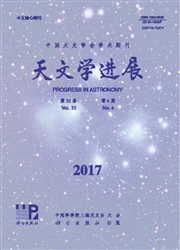

 中文摘要:
中文摘要:
简述了岁差P03模型提出的背景情况;指出IAU1976岁差模型的缺陷,IAU2000A岁差和章动模型中虽有改进但仍不完善;对IAU2006岁差模型(即Capitaine提出的P03模型)作了介绍,并将其与其他岁差模型L77,B03和F03进行了比较;述及GCRS至ITRS的2种表达方法:基于春分点的岁差和章动旋转角方法和运动参考架CIO的X、Y、s的方法;给出了CIP和CIO位置确定的各种方法以及其精度;最后叙述了20世纪IAU采用的岁差一章动模型和IAU天文常数工作组的有关情况,给出了在惯性参考架中“非旋转原点”的运动。
 英文摘要:
英文摘要:
Based on the IAU 2000 resolution the MHB2000 and corrective value of the precession rate of L77 have been adopted since January 11 2003. The background of submitting precession mode P03 is briefly described. The disadvantages of IAU 1976 precession mode are given such as the precession rates in error by about -3 mas/a in longitude and -0.25 mas/a in obliquity comparing with VLBI observations, the obliquity at J2000.0 in error by 0.04" based on LLR and planetary observations, imperfection of the Newcomb's solution and 1976 values for planetary mass etc. Moreover the precession rate of the IAU 2000 precession-nutation is an experienced value and is not consistent with dynamical theory. The IAU 2006 precession mode i.e. P03 proposed by N. Capitation is introduced. The improvements of ecliptic precession and equatorial precession were implemented. For example, the analytical theory VSOP87 fitted to the JPL ephemerides DE406 for the motion of the ecliptic is adopted in the P03 model. The model for the precession of the equator has been obtained by solving the dynamical precession equations based on the most recent expressions for the theoretical contributions to precession and on the MHB estimates of precession rates. All of the perturbing effects on the observed quantities were estimated. Two equivalent bias-precession- nutation transformation from GCRS to ITRS, namely the CIO-base transformation (new one) and equinox-based transformation(classical one) are given. The method based on the"rotation vector" concept for transformation from GCRS to ITRS is also mentioned. The relationship between these methods is expressed. The comparisons for the precession of the ecliptic and the equator between different methods such as Bretagnon et a1.(2003), Fktkushima (2003), Lieske (1977),Capitaine(2003a) are shown in Fig. 1-4. Four methods of generating the CIP coordinates are expressed. The accuracy related such as dependence on the parameters of the precession model, dependence of the choice
 同期刊论文项目
同期刊论文项目
 同项目期刊论文
同项目期刊论文
 期刊信息
期刊信息
